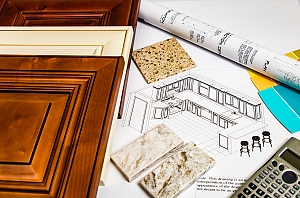Renovating your home can be an exciting yet daunting task. Whether you’re planning a minor makeover or a major transformation, having a clear roadmap is essential to ensure that the process runs smoothly and that you achieve your desired results.
In this comprehensive guide, we will take you through each step of the interior home renovation process with our handy checklist.
Pre-Renovation Planning
Setting Renovation Goals and Objectives
 Before diving into your renovation project, it’s crucial to define your goals and objectives. Are you renovating to increase the resale value of your home, create more functional living spaces, or simply update the aesthetics? Clarifying your objectives will help you make informed decisions throughout the process.
Before diving into your renovation project, it’s crucial to define your goals and objectives. Are you renovating to increase the resale value of your home, create more functional living spaces, or simply update the aesthetics? Clarifying your objectives will help you make informed decisions throughout the process.
Establishing a Realistic Budget
Creating a realistic budget is the cornerstone of any successful renovation. Determine how much you’re willing to invest in your project and allocate funds to different aspects, such as labor, materials, and unexpected expenses. Don’t forget to include a contingency fund for unforeseen issues.
Researching and Hiring the Right Professionals
Selecting the right professionals for your renovation is pivotal. Research contractors, designers, architects, and other experts carefully.
Check references, verify credentials, and request multiple quotes. Collaborating with experienced and reputable professionals ensures quality workmanship.
Obtaining Necessary Permits and Approvals
Depending on the scope of your renovation, you may need permits and approvals from local authorities. Be sure to research the requirements in your area and acquire the necessary paperwork to avoid legal hassles down the line.
Defining Your Renovation Scope
Identifying Which Rooms or Areas to Renovate
Take a close look at your home and identify the specific rooms or areas you want to renovate. Prioritize these spaces based on your goals and budget, focusing on high-impact areas that will make the most significant difference to your home.
Creating a Detailed Project Plan
A well-thought-out project plan is your roadmap to success. Work with an interior designer or architect to create detailed plans, including layouts, designs, and material selections. This plan will guide your renovation and help you avoid costly mistakes.
Setting Priorities for Each Space
Each space you renovate may have unique priorities. Consider functionality, aesthetics, and any special requirements for each room. Make a list of must-haves and nice-to-haves to help you make decisions during the renovation process.
Considering Future Needs and Trends
Think long-term when planning your renovation. Consider how your family’s needs may change over time and try to incorporate designs and features that will stand the test of time. Additionally, stay updated on interior design trends for inspiration.
Design and Layout
Working with an Interior Designer or Architect
 Interior designers and architects bring expertise and creativity to your project. Collaborate closely with them to ensure that your design vision is brought to life while adhering to practical considerations like functionality and budget.
Interior designers and architects bring expertise and creativity to your project. Collaborate closely with them to ensure that your design vision is brought to life while adhering to practical considerations like functionality and budget.
Selecting Materials, Colors, and Finishes
Materials, colors, and finishes play a significant role in the overall look and feel of your home. Choose these elements thoughtfully, keeping in mind your design goals and budget constraints. Consider sustainable and energy-efficient options to enhance your home’s efficiency.
Creating a Floor Plan and Layout
A well-planned layout can make your home more functional and comfortable. Work with professionals to create a floor plan that maximizes space utilization and flow between rooms. Be open to revisions and adjustments as needed.
Considering Energy-Efficient and Sustainable Options
Incorporating energy-efficient and sustainable features into your renovation not only benefits the environment but can also reduce long-term operating costs. Explore options such as energy-efficient appliances, LED lighting, and eco-friendly building materials.
Budget Management
Tracking Expenses and Staying Within Budget
Effective budget management is crucial to the success of your renovation. Keep detailed records of expenses, track your spending against your budget, and make adjustments as necessary to avoid overspending.
Allocating Funds for Unexpected Costs
Renovations often come with surprises. Allocate a portion of your budget for unexpected expenses or changes in plans. Having a contingency fund can help you address these issues without derailing your project.
Comparing Quotes from Contractors and Suppliers
Don’t rush into hiring contractors or purchasing materials. Obtain multiple quotes from different contractors and suppliers to ensure that you’re getting the best value for your money. Consider factors like reputation, experience, and references when making your choices.
Understanding the Importance of Contingency Funds
A contingency fund is your safety net during the renovation process. It can help you handle unforeseen issues or changes in scope without causing financial stress. Aim to set aside at least 10-20% of your total budget for contingencies.
Hiring Contractors and Suppliers
Researching and Interviewing Potential Contractors
 Choosing the right contractor is one of the most critical decisions you’ll make. Conduct thorough research, interview potential contractors, and ask for references. Select a contractor who aligns with your project goals and communicates effectively.
Choosing the right contractor is one of the most critical decisions you’ll make. Conduct thorough research, interview potential contractors, and ask for references. Select a contractor who aligns with your project goals and communicates effectively.
Checking References and Credentials
Don’t hesitate to ask contractors for references from previous clients. Contact these references to inquire about their experiences with the contractor’s work. Additionally, verify that the contractor is licensed and insured to protect your investment.
Getting Multiple Quotes and Bids
To ensure competitive pricing, obtain multiple quotes and bids from contractors. Compare the proposals carefully, taking into account the scope of work, materials, and timelines. Avoid choosing the lowest bid if it compromises the quality of work.
Signing Contracts with Clear Terms and Timelines
Before work begins, it’s essential to have a clear and legally binding contract in place. The contract should outline the scope of work, payment schedule, timelines, and dispute resolution procedures. Review it carefully and seek legal advice if necessary.
Project Timeline
Creating a Renovation Schedule
A well-structured renovation schedule outlines when each phase of the project will be completed. Collaborate with your contractor to create a realistic timeline that takes into account all aspects of the renovation.
Setting Milestones and Deadlines
Breaking your renovation into milestones and deadlines helps you track progress and stay on schedule. Ensure that your contractor and team understand the importance of meeting these deadlines.
Managing Delays and Unexpected Challenges
Renovations rarely go without a hitch. Be prepared for unexpected delays or challenges and communicate openly with your contractor when issues arise. A flexible schedule can help accommodate unforeseen setbacks.
Communicating with the Renovation Team Regularly
Regular communication with your renovation team is key to a successful project. Schedule regular check-ins, address concerns promptly, and keep everyone informed about changes or decisions.
Demolition and Preparation
Clearing Out the Space
Before construction begins, clear out the space being renovated. Remove furniture, belongings, and any items that could be damaged during the renovation. Properly store or protect valuable possessions.
Ensuring Safety Measures Are in Place
Safety should be a top priority during the renovation process. Ensure that safety measures, such as barricades, warning signs, and protective gear, are in place to prevent accidents and injuries.
Handling Hazardous Materials Responsibly
If your renovation involves the removal of hazardous materials like asbestos or lead paint, hire professionals who are trained to handle these substances safely. Failure to do so can lead to health risks and legal issues.
Preparing the Site for Construction
Prepare the renovation site by securing any necessary permits, disconnecting utilities, and ensuring access for construction equipment.
Clear the area of obstacles and create a safe and organized workspace for the renovation team.
Construction and Renovation
Overseeing the Work Progress
Stay involved in the renovation process by regularly checking on the work’s progress. Ask questions, address concerns, and provide feedback to ensure that the project aligns with your vision.
Inspecting Quality of Workmanship
Quality control is essential to a successful renovation. Inspect the workmanship closely to ensure that it meets your standards and specifications. Address any issues or deficiencies promptly.
Managing Changes and Modifications
It’s not uncommon for homeowners to make changes or modifications to the original plan as the renovation progresses. Communicate any changes with your contractor, and be aware that they may impact the budget and timeline.
Addressing Any Issues or Concerns Promptly
If you encounter any issues or concerns during the renovation, don’t hesitate to discuss them with your contractor. Timely communication can help resolve problems and maintain a positive working relationship.
Finishing Touches
Installing Fixtures, Appliances, and Furnishings
As the renovation nears completion, fixtures, appliances, and furnishings are installed. Pay attention to the placement and functionality of these elements to ensure they meet your expectations.
Painting and Finalizing Interior Details
Painting and final interior details can significantly impact the overall aesthetics of your home. Choose paint colors carefully and ensure that all finishing touches are completed to your satisfaction.
Ensuring Everything Is Up to Code
Throughout the renovation, ensure that all work meets local building codes and regulations. This is crucial for your safety and for avoiding potential legal issues in the future.
Conducting a Final Walkthrough with the Contractor
Before finalizing the project, conduct a walkthrough with your contractor to inspect the completed work. Note any deficiencies or touch-ups that need to be addressed before final approval.
Post-Renovation Cleanup
Cleaning and Tidying the Renovated Spaces
After the renovation is complete, thoroughly clean and tidy the renovated spaces. Remove construction dust and debris to make your home safe and comfortable.
Proper Disposal of Construction Debris
Dispose of construction debris responsibly. Follow local regulations for disposal or hire a waste removal service to ensure that materials are handled and disposed of correctly.
Conducting a Safety Inspection
Prior to moving back into the renovated spaces, conduct a safety inspection. Check that all electrical, plumbing, and HVAC systems are functioning correctly and that there are no safety hazards.
Preparing for the Move-In
Prepare for the move-in by unpacking and arranging your belongings in the newly renovated areas. Enjoy the transformation of your home and the enhanced living spaces.
Final Inspections and Approvals
Obtaining Necessary Permits and Inspections
If required, obtain any final permits and inspections to ensure that your renovation complies with all building codes and regulations.
Addressing Any Outstanding Issues
Before concluding the project, address any outstanding issues or deficiencies with your contractor. Ensure that all work meets your expectations and is completed to your satisfaction.
Confirming Project Completion with the Contractor
Once all work is finished, confirm project completion with your contractor. This includes finalizing any remaining payments and obtaining documentation of warranties or guarantees for the work performed.
Settling In
Organizing and Decorating the Newly Renovated Spaces
Now that your renovation is complete, take the time to organize and decorate the newly renovated spaces. Personalize your home with furnishings and decor that reflect your style.
Adapting to Changes in the Home
As you settle into your newly renovated home, adapt to the changes in your living spaces. Explore how the renovations have improved your daily life and functionality.
Enjoying the Benefits of the Renovation
Enjoy the fruits of your labor. Revel in the enhanced comfort, aesthetics, and functionality of your renovated home. Celebrate the achievement of your renovation goals.
Reach Out to the Northern Virginia Home Renovation Professionals
A successful interior home renovation is the result of careful planning, budget management, and collaboration with experienced professionals. By following this comprehensive checklist, you can navigate the renovation process with confidence, turning your vision for a better home into a reality.
If you are remodeling your Northern Virginia home, don’t hesitate to reach out to Dirt Connections for a free consultation. Contact us today to get your home renovation process started.








































